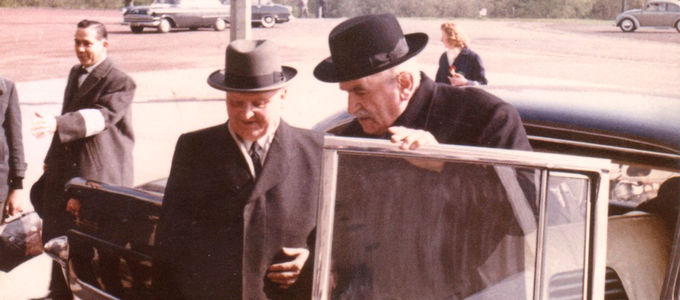
It is not all that uncommon for a pendulum to swing to the other side. This too is part of the story of Chief Apostle Johann Gottfried Bischoff, who died on 6 July sixty years ago—to the dismay of many brothers and sisters.
“It is an illusion to think that Jesus dwells only in the Apostle’s flesh.” It was an Apostle who wrote this to a colleague in 1918. “Unfortunately, it happens all too often that the messengers are given more credit than the sender,” it says in the letter by Johann Gottfried Bischoff addressed to Carl August Brückner. “And this is what we must achieve: the Lord, as the foundation and cornerstone, must be given the right place in His work.”
What was that all about? The context often speaks of the “doctrine of the new light”—even though this designation had initially been used as a disparaging nickname. C. J. Vleck, a prophet, had come up with this title in 1897 amid a dispute concerning the succession of the late Apostle Schwarz in the Netherlands.
A doctrine that was never drawn up
In essence, the conflict centred on the question—as had already been the case at the separation of the future New Apostolic Church from the Catholic Apostolic Church (CAC)—which of the leaders of the Church would be in charge: the prophets, who had been equated with “light” since the days of the Catholic Apostolic Church, or the Apostles (“rule”), whose ambition to lead was mocked by the prophet as the “new light”.
The New Apostolic Church has not formulated any concrete doctrinal statements on this subject in its creeds. And the assertion that the one or the other Chief Apostle had advocated this idea comes solely from their opponents. Meanwhile, it is documented that the Church leadership expressly opposed the so-called “doctrine of the new light” in 1910 in Berlin, for example.
Supporters expelled
Yet, the idea found supporters, whose notions reached a critical point. This was the case, for example, with Julius Fischer, a District Elder in Brandenburg (Germany), and his followers, for whom Christ had already appeared in the Apostles and for whom no other return would take place. In 1902 he was expelled from the Church.
Nevertheless, the idea stuck—especially in the Netherlands. There it was District Apostle Johannes Hendrik van Oosbree, who in his later years cultivated the idea that Christ had already returned and was walking on earth in the Apostles. In 1945 he broke with the New Apostolic Church.
The dogma and its consequences
Both historians close to the Church and critics of the Church do not dispute this: as Apostle and Chief Apostle, Johann Gottfried Bischoff did much to counteract such excesses and to put the imminent return of Christ at the centre of the faith.
“Unfortunately, things came to a head later on,” Chief Apostle Wilhelm Leber said in 2010. He was referring less to Bischoff’s conviction that Christ would return in his lifetime. Rather, the point was that this so-called message had been elevated to a doctrine, which candidates for ordination and sealing had to expressly consent to.
Reconciled towards the future
This dogmatisation caused a lot of suffering, Chief Apostle Leber admitted in 2013 in his statement on this chapter in our Church history: polarisation and the formation of different camps, hostilities and disputes, exclusions and schisms. “I feel a need to apologise to those who suffered as a result of Chief Apostle Bischoff’s message.”
These statements were a decisive step towards reconciliation with the parties involved in the dispute at the time. In 2014, a joint declaration was signed during a special ceremony: “The United Apostolic Church and the New Apostolic Church wish to reconcile and move forward in mutual respect for one another.”
Photo: Before his last divine service on Easter 1960, Chief Apostle Johann Gottfried Bischoff with his successor Walter Schmidt




